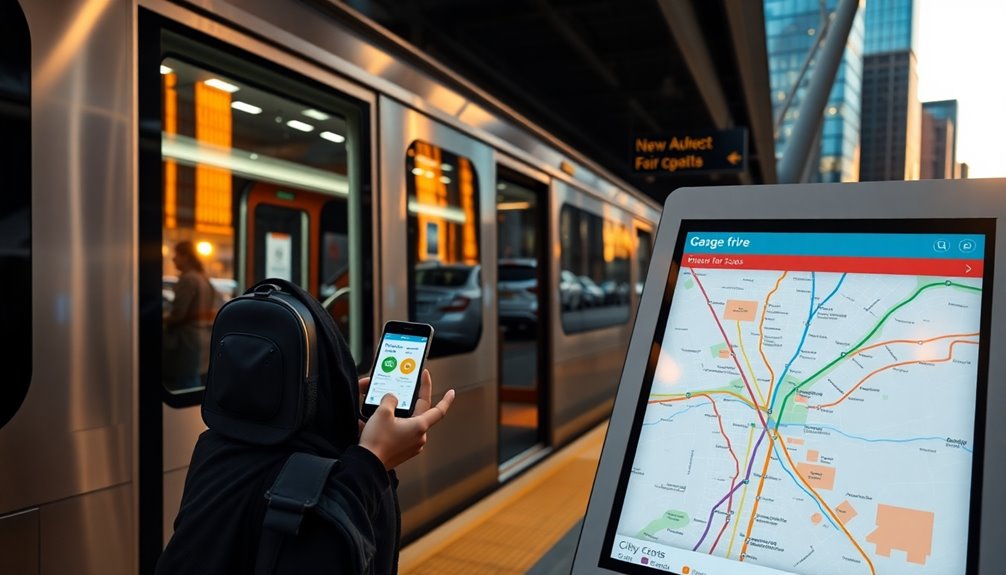When adjusting your finances for a new city, start by researching local costs like rent, transportation, and dining. Create a budget that includes initial moving expenses and ongoing bills, and aim to build an emergency fund. Compare housing options, prioritize essential spending, and explore ways to boost your income if needed. Planning ahead for utilities and transportation helps prevent surprises. Continue exploring these strategies to better understand how to make your finances fit your new environment.
Key Takeaways
- Research local costs for housing, utilities, transportation, and entertainment to create an accurate budget.
- Prioritize building an emergency fund and track expenses to adapt spending habits effectively.
- Compare neighborhood amenities and transportation options to find affordable, suitable areas.
- Negotiate lease terms and explore cost-saving options like community coupons or online deals.
- Adjust income and spending, focusing on essentials and reducing discretionary expenses to maintain financial stability.
Researching the Cost of Living in Your New City

Before you move, conducting thorough research on the cost of living in your new city is essential. Start by exploring the local cuisine, which can vary greatly in price depending on where you dine and how often you indulge. Knowing the average cost of meals, groceries, and dining out helps you plan your expenses effectively. Additionally, look into cultural events—festivals, concerts, and community activities—that you might want to attend. These events often have entry fees or costs associated with participation, and understanding these expenses helps you set realistic expectations. Researching these aspects gives you a clearer picture of daily expenses, so you can budget accordingly and avoid surprises once you’re settled. Being informed empowers you to enjoy the local culture without financial stress. Understanding local amenities also helps you anticipate ongoing costs and lifestyle differences. Furthermore, examining cost of entertainment options available in your new city can help you allocate your budget more effectively. Exploring local transportation options can further aid in planning your commuting expenses and overall mobility costs. Additionally, reviewing AI security considerations can help you protect your personal data and digital assets during your move.
Budgeting for the Transition Period

Once you’ve researched the cost of living in your new city, it’s time to create a budget that covers your initial expenses. Focus on your financial literacy to understand where your money will go during this changeover. List essential costs like moving, deposits, and daily expenses, and set aside an emergency fund for unexpected costs. Prioritize debt management by avoiding new debt and paying down existing obligations if possible. Keep track of your spending to guarantee you stay within your budget, adjusting as needed. A clear, realistic plan helps you navigate the financial uncertainties of moving and prevents overspending. Remember, sticking to your budget during this period assures you maintain financial stability while settling into your new environment. Additionally, understanding the cost of living in your destination can help you set more accurate financial goals and avoid surprises.
Comparing Housing Options and Expenses

When comparing housing options, you’ll notice rental prices can vary widely between neighborhoods, affecting your budget. Homeownership costs, like property taxes and maintenance, also differ based on location and property type. Consider what amenities each area offers to guarantee your choice aligns with your lifestyle and financial goals.
Rental Price Variations
Have you noticed how rental prices can vary dramatically between neighborhoods and housing types? The rental market is often segmented, with some areas commanding higher prices due to demand, amenities, or proximity to work. To make the most of your budget, compare options carefully, considering both rent and what’s included. When negotiating a lease, don’t hesitate to ask for discounts or flexible terms—many landlords are open to negotiations, especially if you’re a reliable tenant. Be aware that rental prices can fluctuate based on seasonality or market trends, so timing your move strategically can save you money. Additionally, understanding the cost of living in a new city can help you better plan your budget and housing choices. Being aware of local market trends can also give you an advantage when searching for affordable options. For example, some cities experience seasonal fluctuations in rental prices, which can impact your decision on when to move. Recognizing these rental market variations will help you better navigate the rental market and find options that fit your financial situation. Staying informed about these market fluctuations can help you capitalize on lower rates during off-peak periods.
Homeownership Costs Differences
Comparing homeownership costs involves understanding the different expenses associated with buying versus renting. When evaluating options, consider factors like a mortgage comparison, property taxes, and maintenance costs. Owning a home often means higher upfront costs but can build equity over time. Renting typically offers more flexibility but less long-term financial benefit. Additionally, understanding asset division laws can be important if you are planning for financial stability or future asset management.
Key differences include:
- Mortgage payments, which vary based on interest rates and loan terms
- Property taxes, which differ markedly between locations
- Maintenance and repair expenses that owners are responsible for, unlike renters
Knowing these costs helps you make an informed decision aligned with your financial situation. Be sure to compare mortgage options carefully and factor in local property tax rates to understand the true expense of homeownership in your new city.
Comparing Neighborhood Amenities
Evaluating neighborhood amenities is essential to finding a housing option that fits your lifestyle and budget. Consider factors like local park access, which can enhance your quality of life and provide free outdoor activities. Neighborhood safety is equally important; research crime rates and talk to residents to gauge how secure you’ll feel. Comparing these amenities helps you identify areas that align with your priorities and financial situation. For example, neighborhoods with nearby parks may come with higher rent, but they offer more recreational value. Conversely, safer neighborhoods might cost more but provide peace of mind. Understanding the importance of digital literacy and online safety can also influence your choice, especially if you want to ensure your family is comfortable navigating technology. Developing strong online safety habits can help protect your personal information and maintain your privacy in your new community. Additionally, considering space optimization options within neighborhoods can help you make the most of your living environment, ensuring your home remains functional and organized. Incorporating knowledge about local amenities and community resources can further enhance your living experience. Staying aware of market trends and insights can help you make more informed decisions about affordability and future value. By weighing these factors, you can find a neighborhood that offers the right balance of amenities and affordability, making your shift smoother and your new environment more enjoyable.
Adjusting Your Income and Spending Habits

To adapt to your new city’s cost of living, start by realigning your budget to focus on essential expenses. Consider adjusting your income or finding ways to increase it if needed. Prioritizing what truly matters helps you make smarter spending choices and stay financially stable. Being mindful of daily expenses can help you avoid overspending and maintain financial health. Additionally, understanding interior design planning and how they impact your bicycle’s performance can save you money on repairs and prolong the life of your equipment. Recognizing the importance of financial planning tools can further enhance your ability to manage your finances effectively in a new environment. For instance, knowing the cost range of electric bikes can help you set realistic expectations when budgeting for transportation options.
Budget Realignment Strategies
When adjusting to a new city’s higher or lower cost of living, it’s essential to realign your budget by modifying your income and spending habits. Start by exploring cost cutting techniques and savings strategies that fit your new financial landscape. Consider:
- Cutting non-essential expenses like dining out or subscriptions
- Finding more affordable housing options or renegotiating rent
- Increasing your income through side gigs or freelance work
- Incorporating sound healing techniques into your routine to potentially reduce stress-related expenses and improve overall well-being. Developing conflict resolution skills can also help in negotiating better deals or resolving disputes over expenses, further enhancing your financial stability. Additionally, understanding the dog names that resonate with your lifestyle can help in budgeting for pet-related expenses more effectively. Being aware of cost-effective beauty routines can also save money while maintaining your appearance. Exploring home decor ideas, such as wall organization or stylish serveware, can also help make your space more functional and inviting without overspending.
These adjustments help you stay afloat without sacrificing your financial goals. By proactively re-evaluating your spending, you’ll better manage your resources and adapt smoothly. Remember, small changes can lead to significant savings over time. Developing a flexible approach ensures your budget remains balanced, regardless of the city’s living costs.
Prioritize Essential Expenses
After making adjustments to cut unnecessary expenses and find affordable housing, it’s time to focus on prioritizing your essential costs. Start by identifying what’s truly necessary, like rent, utilities, groceries, transportation, and healthcare. Avoid luxury spending and discretionary expenses that can quickly drain your budget. Keep your spending aligned with your new city’s cost of living by limiting non-essential purchases. Consider setting strict limits on dining out, entertainment, and shopping. By concentrating on essentials, you ensure your money covers your basic needs first, preventing financial stress. Incorporating budgeting strategies can further enhance your ability to manage expenses effectively. This disciplined approach helps you build stability and adapt smoothly to your new environment, making your finances more manageable and giving you peace of mind as you settle into the city.
Planning for Transportation Costs

Since transportation costs can vary widely depending on your new city, it’s essential to evaluate your options early on. Consider the different ways you might commute, such as:
- Public transportation passes or daily tickets
- Ride sharing options like Uber or Lyft
- Owning and maintaining a car
Public transportation can be cost-effective if it’s reliable and accessible, helping you save on fuel and parking. Ride sharing offers flexibility without the upfront costs of a vehicle. If you plan to drive, factor in expenses like insurance, gas, and maintenance. Assess your daily commute and lifestyle to determine the most economical choice. Planning ahead helps prevent unexpected expenses and keeps your budget on track as you settle into your new city.
Managing Utilities and Essential Services

Managing utilities and essential services is crucial to keeping your monthly expenses under control as you settle into your new city. Start with a utility setup by researching local service providers for electricity, water, gas, and internet. Comparing plans and prices ensures you get the best deal and avoid overpaying. Contact providers early to schedule installations and set up billing accounts. Be aware of any deposits or fees required, especially if your credit history is limited. Keep track of your usage to prevent surprises on your bills. Setting up essential services efficiently helps you avoid disruptions and keeps costs predictable. By choosing reliable service providers and staying organized, you’ll manage your utilities smoothly and maintain your budget in your new environment.
Building an Emergency Fund for Unexpected Expenses

Building an emergency fund is a vital step to protect yourself against unexpected expenses that can arise in a new city. Moving introduces surprises like sudden medical bills, car repairs, or job uncertainties. Having a dedicated fund boosts your emergency preparedness and financial stability. To start, consider these essentials:
- Save at least three to six months’ worth of living expenses
- Automate regular contributions to your fund
- Keep the money in a separate, easily accessible account
This way, you’re prepared for surprises without disrupting your daily life. An emergency fund reduces stress and helps you navigate unforeseen financial challenges confidently. Prioritizing this safety net guarantees that unexpected expenses won’t derail your financial progress in your new city. Stay disciplined, and your fund will grow, giving you peace of mind in any situation.
Seeking Local Deals and Discount Opportunities

After establishing your emergency fund, you can focus on stretching your budget further by seeking local deals and discount opportunities. Look for community coupon books, online deal sites, and mobile apps that offer discounts at local restaurants, stores, and services. Many cities have weekly flyers or email newsletters highlighting special promotions. Don’t overlook loyalty programs or student and senior discounts, which can save you money regularly. Attending local events or markets can also uncover exclusive deals. By actively searching for and taking advantage of these discount opportunities, you maximize your spending power without sacrificing quality or convenience. Being resourceful with local deals not only saves you money but helps you integrate into your new community more affordably.
Frequently Asked Questions
How Can I Find Affordable Healthcare Options in My New City?
To find affordable healthcare options in your new city, start by researching local affordable clinics and community health centers, which often offer sliding scale fees. Check out different insurance options, including marketplace plans or Medicaid if you’re eligible, to locate coverage that fits your budget. You can also compare plan costs and benefits online to guarantee you’re getting the best deal, making healthcare both accessible and affordable.
What Are Effective Ways to Build Local Social Connections on a Budget?
Like building a mosaic, forming local social connections takes patience and effort. You can find affordable ways by attending local meetups or community events, where you’ll meet like-minded people. Volunteering is another great option, offering meaningful interactions without spending much. These activities help you create genuine bonds, making your new city feel like home faster. Immerse yourself, stay open, and enjoy the enriching experiences that come with getting involved.
How Do Tax Rates Differ Between My Previous City and the New One?
You should compare the tax brackets and income taxes between your previous city and your new one. Look up each location’s tax rates and understand how they impact your paycheck. Keep in mind that some cities have higher local taxes or different deductions, which could affect your overall tax burden. By doing this, you’ll get a clear picture of how your finances might change and plan accordingly.
What Are Some Hidden Costs Associated With Moving to a New City?
Moving to a new city comes with hidden costs you might not expect. You’ll face moving expenses like hiring movers or renting a truck, which can add up quickly. Additionally, utility setup fees for electricity, water, and internet often catch people off guard. These costs can strain your budget if you’re not prepared, so plan ahead to cover these hidden expenses and avoid financial surprises during your move.
How Can I Access Community Resources for Financial Assistance?
You can access community resources for financial assistance by researching local organizations and government programs. Look for community grants aimed at newcomers or low-income residents, which often provide financial support. Attend free financial workshops offered by community centers or nonprofits to improve your money management skills. These resources can help you navigate your new city’s cost of living more effectively and guarantee you’re aware of all available financial aid options.
Conclusion
Adjusting your finances is like planting seeds in new soil—you must understand the terrain, nurture your resources, and stay adaptable. As you navigate your new city’s cost of living, remember that each careful step helps your financial garden flourish. With patience and planning, you’ll cultivate stability and growth, turning unfamiliar ground into a foundation for your future. Embrace the journey, and watch your financial landscape blossom amid new opportunities.









